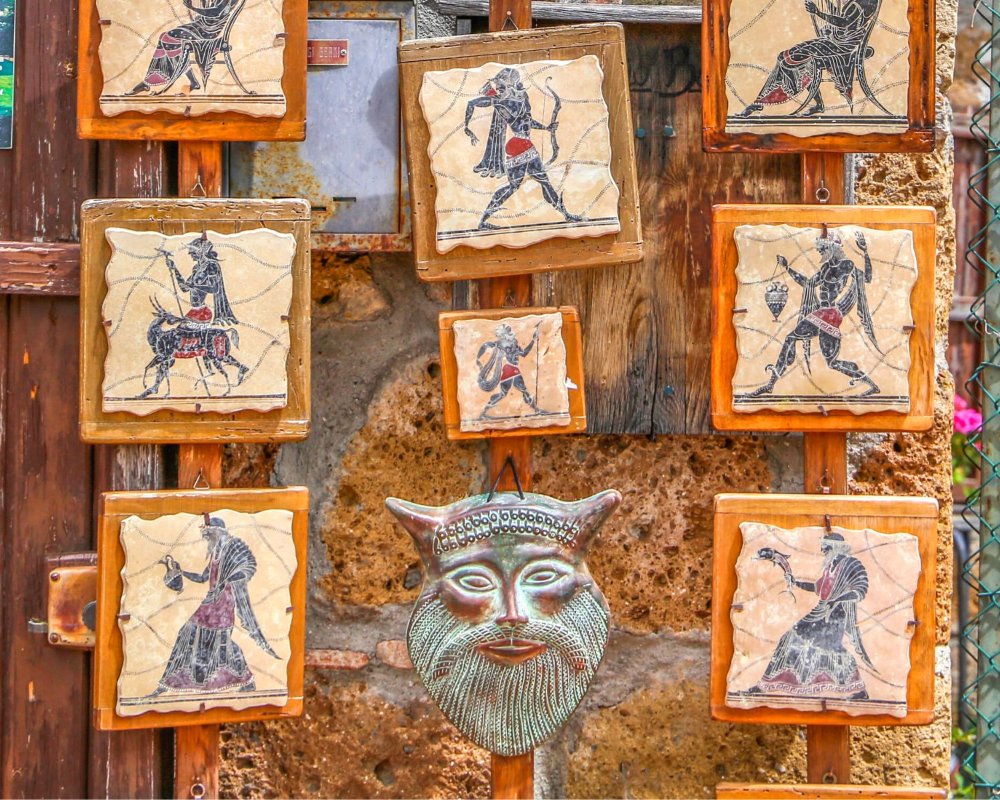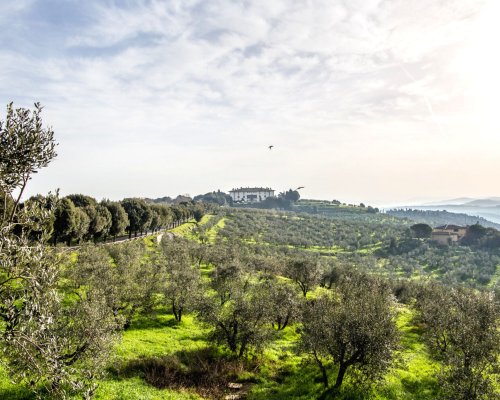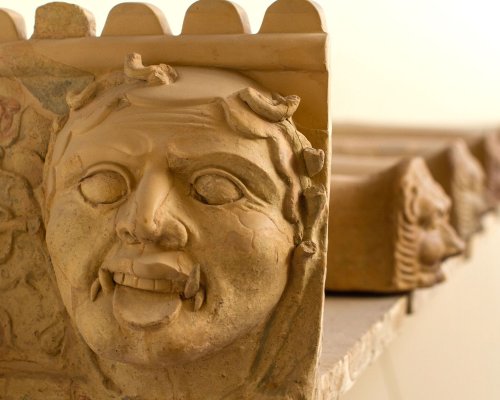An Etruscan epic through cities, museums and archaeological sites in Tuscany
The Etruscan people, their mysterious world, the expressions of their culture, have always ignited the curiosity and interest of archaeologists but also of the less experienced in the field; whoever reads, listens to or stands in the presence of any Etruscan testimony cannot help but be fascinated by it.
But what heritage did the Etruscans leave to the land of Tuscany? In the following stages we explore for each municipality the characteristic aspects of this people through charming villages, museums and archaeological areas.
A Tuscan itinerary from north to south, focused primarily on the archaeological museums and areas of excellence, among the most attractive located in central Italy, with the aim of exploring the characteristic aspects of the Etruscans, such as their organisation into city-states and the particular emphasis given to aspects of the funerary cult which led to the creation of extensive and monumental necropolises.
The Montalbano area and the Artimino hills in particular, thanks to the proximity of the Arno River, which in Etruscan times was navigable by various vessels, were the crossroads of trade and saw an important Etruscan centre spring up in this area. A flourishing history, above all in the Orientalizing period, that can now be relived thanks to the finds preserved in the Archaeological Museum of Artimino, the necropolis of Prato Rosello of the Archaeological Park of Carmignano and the Tumulus of Montefortini and Boschetti in the archaeological area of Comeana.
The Montalbano area and the Artimino hills in particular, thanks to the proximity of the Arno River, which in Etruscan times was navigable by various vessels, were the crossroads of trade and saw an important Etruscan centre spring up in this area. A flourishing history, above all in the Orientalizing period, that can now be relived thanks to the finds preserved in the Archaeological Museum of Artimino, the necropolis of Prato Rosello of the Archaeological Park of Carmignano and the Tumulus of Montefortini and Boschetti in the archaeological area of Comeana.
Standing on a hill overlooking the surrounding valleys, the picturesque medieval town of Castiglion Fiorentino was originally founded in Etruscan times. It has an extensive heritage, which can also be appreciated by walking through the historic centre. For instance, the Cassero Tower was built in the 14th century on a pre-existing Etruscan structure as were the walls, while the archaeological museum housed in the Praetorian Palace has many important bronze and terracotta items found in the area and in the Cassero temple.
Standing on a hill overlooking the surrounding valleys, the picturesque medieval town of Castiglion Fiorentino was originally founded in Etruscan times. It has an extensive heritage, which can also be appreciated by walking through the historic centre. For instance, the Cassero Tower was built in the 14th century on a pre-existing Etruscan structure as were the walls, while the archaeological museum housed in the Praetorian Palace has many important bronze and terracotta items found in the area and in the Cassero temple.
Strategically positioned on a hill too, Cortona was a powerful Etruscan city, the ancient religious city state of Coritus, part of the Etruscan Dodecapolis. Evidence of its Etruscan origins can be admired throughout the splendid town: the walls, the Porta Bifora, or the foundations of Casali Palace which now houses MAEC, the Etruscan Academy Museum of the City. All around, the archaeological park which has 11 sites, among which the mound of Sodo stands out.
Strategically positioned on a hill too, Cortona was a powerful Etruscan city, the ancient religious city state of Coritus, part of the Etruscan Dodecapolis. Evidence of its Etruscan origins can be admired throughout the splendid town: the walls, the Porta Bifora, or the foundations of Casali Palace which now houses MAEC, the Etruscan Academy Museum of the City. All around, the archaeological park which has 11 sites, among which the mound of Sodo stands out.
Etruscan traces can even be found in the DNA of the inhabitants of Murlo, as revealed by some university research carried out in the '80s. This fascinating medieval castle immersed in the Sienese countryside, in the collection of the Antiquarium Etruscan Museum of Poggio Civitate, boasts of grave goods from the necropolis of Poggio Aguzzo and artefacts found in the princely palace from the 7th-6th century B.C. on the hill of Poggio Civitate, now a very important archaeological site.
Etruscan traces can even be found in the DNA of the inhabitants of Murlo, as revealed by some university research carried out in the '80s. This fascinating medieval castle immersed in the Sienese countryside, in the collection of the Antiquarium Etruscan Museum of Poggio Civitate, boasts of grave goods from the necropolis of Poggio Aguzzo and artefacts found in the princely palace from the 7th-6th century B.C. on the hill of Poggio Civitate, now a very important archaeological site.
A well-known spot in the Valdichiana, Chianciano Terme is home to thermal baths with roots in the Etruscan period and one of the richest museum exhibitions. The Civic Archaeological Museum of Chianciano Terme houses numerous Etruscan reconstructions, such as the burial chambers with mysterious funeral urns called canopic jars, or the vestiges of an Etruscan sanctuary found close to the Sillene spring or a temple pediment with statues and friezes that emerged from Fucoli, a thermal spring still in use today.
A well-known spot in the Valdichiana, Chianciano Terme is home to thermal baths with roots in the Etruscan period and one of the richest museum exhibitions. The Civic Archaeological Museum of Chianciano Terme houses numerous Etruscan reconstructions, such as the burial chambers with mysterious funeral urns called canopic jars, or the vestiges of an Etruscan sanctuary found close to the Sillene spring or a temple pediment with statues and friezes that emerged from Fucoli, a thermal spring still in use today.
The Valdichiana, the ancient valley of Clanis, a river sacred to the Etruscans, is also home to another pearl, Chiusi. A hegemonic city in Etruscan times and still pervaded by ancient stories and legends, like that of King Porsenna, the king known to posterity for his military action against Rome in favour of Tarquinius Superbus. Within its walls, Chiusi houses the National Etruscan Museum with a rich collection of finds, including the “Lid of the embrace”. Moreover, it is the only one in Tuscany to preserve painted tombs from the 5th century B.C.; specifically, the Tomb of the Monkey, which is located in the Necropolis of Poggio Renzo and is named after the depiction of a primate on the frieze of the central chamber of the tomb.
The Valdichiana, the ancient valley of Clanis, a river sacred to the Etruscans, is also home to another pearl, Chiusi. A hegemonic city in Etruscan times and still pervaded by ancient stories and legends, like that of King Porsenna, the king known to posterity for his military action against Rome in favour of Tarquinius Superbus. Within its walls, Chiusi houses the National Etruscan Museum with a rich collection of finds, including the “Lid of the embrace”. Moreover, it is the only one in Tuscany to preserve painted tombs from the 5th century B.C.; specifically, the Tomb of the Monkey, which is located in the Necropolis of Poggio Renzo and is named after the depiction of a primate on the frieze of the central chamber of the tomb.
Between the Valdichiana and the Val d'Orcia stands the town of Sarteano; its delightful historical centre is immersed in one of the most beautiful areas of Tuscany and has been inhabited since ancient times. Etruscans populated the area from the 9th to the 1st century B.C. and left a very important legacy preserved in the Civic Archaeological Museum in the centre of the town. Worth visiting is the nearby necropolis of the Pianacce, famous for the Tomb of the Infernal Chariot (4th century B.C.), a sepulchre housing one of the most significant pictorial examples of Etruscan art.
Between the Valdichiana and the Val d'Orcia stands the town of Sarteano; its delightful historical centre is immersed in one of the most beautiful areas of Tuscany and has been inhabited since ancient times. Etruscans populated the area from the 9th to the 1st century B.C. and left a very important legacy preserved in the Civic Archaeological Museum in the centre of the town. Worth visiting is the nearby necropolis of the Pianacce, famous for the Tomb of the Infernal Chariot (4th century B.C.), a sepulchre housing one of the most significant pictorial examples of Etruscan art.
Tuscany's deep south is a true treasure chest of the Etruscan civilisation. Sorano and its fraction Sovana are two tuff cities that safeguard an enormous Etruscan heritage. Joined by the "Città del Tufo" Archaeological Park, this open-air museum includes the Etruscan necropolis of Sovana, the cave settlement of San Rocco and the site of Vitozza in the locality of San Quirico. The park is also dotted with several of the most spectacular excavated pathways, the vie cave, such as the Cavone, the Poggio Prisca via cava and the San Sebastiano via cava.
Tuscany's deep south is a true treasure chest of the Etruscan civilisation. Sorano and its fraction Sovana are two tuff cities that safeguard an enormous Etruscan heritage. Joined by the "Città del Tufo" Archaeological Park, this open-air museum includes the Etruscan necropolis of Sovana, the cave settlement of San Rocco and the site of Vitozza in the locality of San Quirico. The park is also dotted with several of the most spectacular excavated pathways, the vie cave, such as the Cavone, the Poggio Prisca via cava and the San Sebastiano via cava.
Another pearl of the tuff area, Pitigliano is a wonderful hilltop town also known for the Jewish culture it safeguards. Within its walls is the Alberto Manzi Archaeological Museum The City of the Living - The City of the Dead, an open-air museum of strong educational value. In the surrounding area there are numerous canals dug into the tuff, such as the San Giuseppe via cava, in addition to a trace of the world of the dead, the necropolis of Poggio Buco.
Another pearl of the tuff area, Pitigliano is a wonderful hilltop town also known for the Jewish culture it safeguards. Within its walls is the Alberto Manzi Archaeological Museum The City of the Living - The City of the Dead, an open-air museum of strong educational value. In the surrounding area there are numerous canals dug into the tuff, such as the San Giuseppe via cava, in addition to a trace of the world of the dead, the necropolis of Poggio Buco.
Close to the most famous and alluring thermal baths in Tuscany, those of Saturnia, known and loved since the time of the Etruscans who considered them to be sacred, the Etruscan necropolis of Puntone was brought to light in the Manciano area. Immersed in the most thriving and wild vegetation of the Maremma, it consists of around thirty chamber tombs with a tumulus and around ten pit tombs. Very important examples of the cities of the dead of the Etruscan people.
Close to the most famous and alluring thermal baths in Tuscany, those of Saturnia, known and loved since the time of the Etruscans who considered them to be sacred, the Etruscan necropolis of Puntone was brought to light in the Manciano area. Immersed in the most thriving and wild vegetation of the Maremma, it consists of around thirty chamber tombs with a tumulus and around ten pit tombs. Very important examples of the cities of the dead of the Etruscan people.
The city of Grosseto and its surroundings also house small but significant treasures from the Etruscan world. Roselle was one of the twelve Etruscan city states; today it is an archaeological area that can be visited and where both the Etruscan and Roman civilisations can be appreciated. Other important Etruscan artefacts can be found in the Archaeological and Art Museum of Maremma in the heart of the Grossetto city.
The city of Grosseto and its surroundings also house small but significant treasures from the Etruscan world. Roselle was one of the twelve Etruscan city states; today it is an archaeological area that can be visited and where both the Etruscan and Roman civilisations can be appreciated. Other important Etruscan artefacts can be found in the Archaeological and Art Museum of Maremma in the heart of the Grossetto city.
Not only transparent sea and good seafood cuisine: Castiglione della Pescaia, in addition to being a well-known holiday resort, has an extremely rich archaeological heritage. The town of Vetulonia, perched on a hill in the hinterland of Castiglione della Pescaia, houses one of the most important Etruscan museums, the Isidoro Falchi Civic Archaeological Museum, and nearby the archaeological area of Poggiarello Renzetti. The Diaccia Botrona nature reserve was also an area inhabited in ancient times: centuries and centuries ago it was a gulf, where two Etruscan city-states stood.
Not only transparent sea and good seafood cuisine: Castiglione della Pescaia, in addition to being a well-known holiday resort, has an extremely rich archaeological heritage. The town of Vetulonia, perched on a hill in the hinterland of Castiglione della Pescaia, houses one of the most important Etruscan museums, the Isidoro Falchi Civic Archaeological Museum, and nearby the archaeological area of Poggiarello Renzetti. The Diaccia Botrona nature reserve was also an area inhabited in ancient times: centuries and centuries ago it was a gulf, where two Etruscan city-states stood.
The territory of Piombino is dotted with evidence of the Etruscan people, starting with the only city settled on the sea, Populonia, and the wonderful gulf above it, that of Baratti. Also not to be forgotten is the Buca delle Fate, concealed by Mediterranean scrub near beautiful coves washed by the crystal clear sea. Archaeological treasures that can be admired in indoor museum exhibitions, such as the Gasparri Archaeological Museum of Populonia, and outdoor sites, such as the Archaeological Park of Baratti and Populonia.
The territory of Piombino is dotted with evidence of the Etruscan people, starting with the only city settled on the sea, Populonia, and the wonderful gulf above it, that of Baratti. Also not to be forgotten is the Buca delle Fate, concealed by Mediterranean scrub near beautiful coves washed by the crystal clear sea. Archaeological treasures that can be admired in indoor museum exhibitions, such as the Gasparri Archaeological Museum of Populonia, and outdoor sites, such as the Archaeological Park of Baratti and Populonia.


